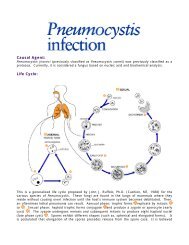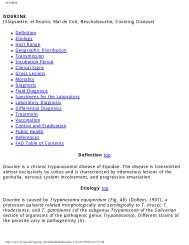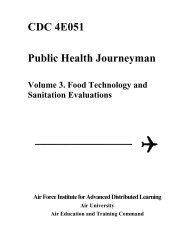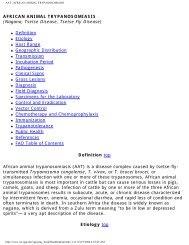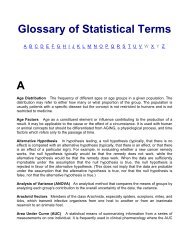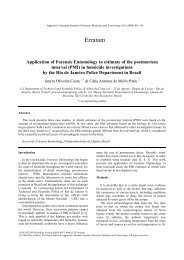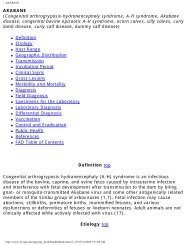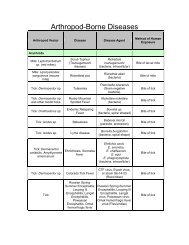Causal Agents: Life Cycle:
Causal Agents: Life Cycle:
Causal Agents: Life Cycle:
Create successful ePaper yourself
Turn your PDF publications into a flip-book with our unique Google optimized e-Paper software.
<strong>Causal</strong> <strong>Agents</strong>:<br />
The cestodes (tapeworms) Taenia saginata (beef tapeworm) and T. solium (pork tapeworm).<br />
Taenia solium can also cause cysticercosis.<br />
<strong>Life</strong> <strong>Cycle</strong>:<br />
<strong>Life</strong> cycle of Taenia saginata and Taenia solium<br />
Humans are the only definitive hosts for Taenia saginata and Taenia solium. Eggs or gravid<br />
proglottids are passed with feces ; the eggs can survive for days to months in the environment.<br />
Cattle (T. saginata) and pigs (T. solium) become infected by ingesting vegetation contaminated<br />
with eggs or gravid proglottids . In the animal's intestine, the oncospheres hatch , invade the<br />
intestinal wall, and migrate to the striated muscles, where they develop into cysticerci. A<br />
cysticercus can survive for several years in the animal. Humans become infected by ingesting raw<br />
or undercooked infected meat . In the human intestine, the cysticercus develops over 2 months<br />
into an adult tapeworm, which can survive for years. The adult tapeworms attach to the small<br />
intestine by their scolex and reside in the small intestine . Length of adult worms is usually 5<br />
m or less for T. saginata (however it may reach up to 25 m) and 2 to 7 m for T. solium. The adults<br />
produce proglottids which mature, become gravid, detach from the tapeworm, and migrate to the
anus or are passed in the stool (approximately 6 per day). T. saginata adults usually have 1,000<br />
to 2,000 proglottids, while T. solium adults have an average of 1,000 proglottids. The eggs<br />
contained in the gravid proglottids are released after the proglottids are passed with the feces. T.<br />
saginata may produce up to 100,000 and T. solium may produce 50,000 eggs per proglottid<br />
respectively.<br />
Geographic Distribution:<br />
Both species are worldwide in distribution. Taenia solium is more prevalent in poorer communities<br />
where humans live in close contact with pigs and eat undercooked pork, and in very rare in Muslim<br />
countries.<br />
Clinical Features:<br />
Taenia saginata taeniasis produces only mild abdominal symptoms. The most striking feature<br />
consists of the passage (active and passive) of proglottids. Occasionally, appendicitis or cholangitis<br />
can result from migrating proglottids. Taenia solium taeniasis is less frequently symptomatic than<br />
Taenia saginata taeniasis. The main symptom is often the passage (passive) of proglottids. The<br />
most important feature of Taenia solium taeniasis is the risk of development of cysticercosis.<br />
Laboratory Diagnosis:<br />
Microscopic identification of eggs and proglottids in feces is diagnostic for taeniasis, but is not<br />
possible during the first 3 months following infection, prior to development of adult tapeworms.<br />
Repeated examination and concentration techniques will increase the likelihood of detecting light<br />
infections. Nevertheless, speciation of Taenia is impossible if solely based on microscopic<br />
examination of eggs, because all Taenia species produce eggs that are morphologically identical.<br />
Eggs of Taenia sp. are also indistinguishable from those produced by cestodes of the genus<br />
Echinococcus (tapeworms of dogs and other canid hosts). Microscopic identification of gravid<br />
proglottids (or, more rarely, examination of the scolex) allows species determination.<br />
TAKE EXTREME CARE IN PROCESSING THE SAMPLES! INGESTION OF EGGS CAN RESULT<br />
IN CYSTICERCOSIS!<br />
Diagnostic findings<br />
Microscopy<br />
Antibody detection may prove useful especially in the early invasive stages, when the<br />
eggs and proglottids are not yet apparent in the stools.<br />
Morphologic comparison with other intestinal parasites<br />
Treatment:<br />
Treatment is simple and very effective. Praziquantel* is the drug of choice.<br />
* This drug is approved by the FDA, but considered investigational for this purpose.





